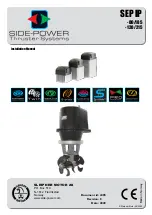DSPAUDIOEVM Users Guide, Rev. 2.4
This document contains information on a new product. Specifications and information herein are subject ot change without notice.
4
Freescale Semiconductor
Configuration Jumpers
2.2.4
Debugger and Microcontroller Configuration
2.2.4.1
PJ6 Debug MPU Crystal Selection
The JP6 jumper is for selection of RS232 or USB communication when using the SDI debugger. Note that USB mode is not possible when
using the Win NT software version. The RS232 position should be jumpered when the RS232 interface is used for the SDI debugger, and the
USB/PGM position should be used when using the USB interface for the SDI debugger or when reprogramming of the Debug Micro is
required. Only one of these jumpers should be connected at any one time. Use of the wrong jumper setting will cause SDI communication
failure to occur or a reduction in the data transfer rate.
2.2.4.2
JP7 – MPU Program Control
The JP7 jumpers are only used when the on-board microcontrollers are to be re-programmed. Placing a jumper in the PGM position places
the selected microcontroller in program mode upon power-on. The microcontroller to be programmed is selected by placing a jumper in either
the DEBUG MPU or CONFIG MPU positions. With no jumper in the PGM position, the other two jumpers are ignored.
2.2.4.3
JP8 – SHI Debug Source Selection
The JP8 jumpers are for selection of various debugger modes. The default selection is for SDI debugger use. The PPI port can be used with
legacy "PPP Development Interface" software and a PPI cable although the latest SDI debugger software is the preferred option for future
upgradability and support. The third option, CONFIG MPU, is not currently supported on the EVM. Only one jumper position should be used
at any one time.
2.2.4.4
JP9 – OnCE/JTAG Debugger Source Selection
The JP9 jumpers are used for selection of alternative debugging tools such as the Suite 56 OnCE interface mentioned earlier. To use this,
simply connect to a host PC with a parallel cable and have a jumper in the PARALLEL positions. The OnCE jumper option can be used if the
user wishes to connect an external OnCE/JTAG debugger interface to the board. The USB/RS232 option is not currently supported and only
one jumper should be inserted at a time.
Table 2-3. JP5 — PASS-THRU Header
MCLK
BICK
LRCLK
SERIAL I / O
M
U
T
E
*
*
*
*
*
*
*
*
*
*
*
*
*
*
*
*
*
*
*
*
*
*
*
*
*
*
*
*
*
*
*
*
*
*
*
*
*
*
*
*
*
*
*
*
*
*
*
*
*
*
*
*
*
*
*
*
*
*
*
*
*
*
*
*
RX0
1
RX0
2
TX
ADC
DA
C
A
DA
C
B
RX
TX
ADC
DA
C
A
DA
C
B
RX
TX
ADC
DA
C
A
DA
C
B
RX
ADC
1
ADC
2
TXS01
DA
C
A
1
/2
TXS02
DA
C
A
3
/4
TXSD3
DA
C
A
5
/6
TXSD4
DA
C
B
1
/2
TXSD5
DA
C
B
3
/4
TXCD6
DA
C
B
5
/6
MU
TE
Table 2-4. Debug and Crystal MPU Settings
JB16
EXTAL
PGM MD
SHI
JTAG
MPU COM
AUX IN=HI
*
*
*
*
*
*
*
*
*
*
*
*
*
*
*
*
*
*
*
*
*
*
*
*
*
*
*
*
*
*
*
*
*
*
*
*
*
*
*
*
R
S
232
USB/PGM
DEBUG M
P
U
CO
NFI
G
M
P
U
PG
M
PPI POR
T
DEBUG M
P
U
CO
NFI
G
M
P
U
On
C
E
USB/RS23
2
P
A
R
A
LLEL
CO
M0
CO
M1
CO
M2
CO
M3
AU
X
1
AU
X
2
AU
X
3
AU
X
4
AU
X
5
JP6
JP7
JP8
JP9
JP10
JP11


















